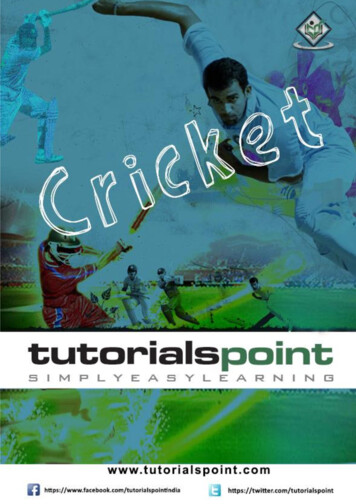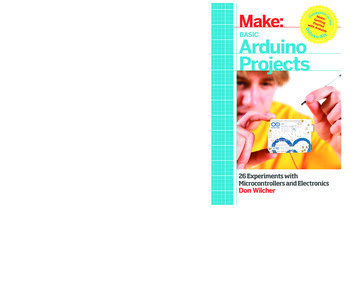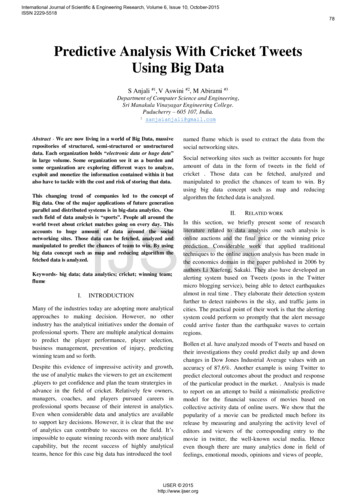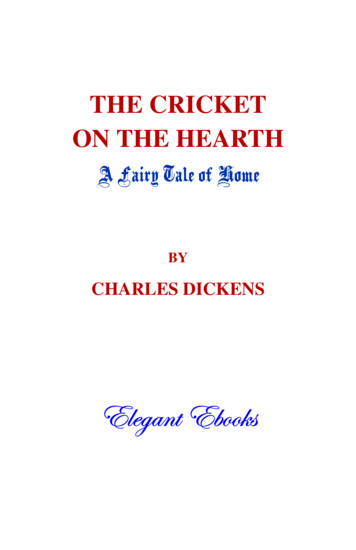
Transcription
CricketAbout the TutorialCricket, initially said to be England’s national summer game, has gainedimmense popularity worldwide. Such is the popularity that it is not onlyrestricted to the professional field, rather people of all ages and gender can beseen playing cricket in their streets and backyards. This tutorial explains thebasic rules of the game. It provides information on the cricket pitch and theimportant gears used during the play. Some important terminologies andlegends of the game are also discussed.The information here is meant to supplement your knowledge on the game.However, it is not a comprehensive guide on how to play.AudienceThis tutorial is meant for anyone who wants to know and learn about cricket. Itis prepared keeping in mind that the reader is unaware about the basics of thegame. It is a basic guide to help a beginner understand the game of cricket.PrerequisitesBefore proceeding with this tutorial, you are required to have a passion forcricket and an eagerness to acquire knowledge on the same.Copyright & Disclaimer Copyright 2015 by Tutorials Point (I) Pvt. Ltd.All the content and graphics published in this e-book are the property ofTutorials Point (I) Pvt. Ltd. The user of this e-book is prohibited to reuse, retain,copy, distribute, or republish any contents or a part of contents of this e-book inany manner without written consent of the publisher.We strive to update the contents of our website and tutorials as timely and asprecisely as possible, however, the contents may contain inaccuracies or errors.Tutorials Point (I) Pvt. Ltd. provides no guarantee regarding the accuracy,timeliness, or completeness of our website or its contents including this tutorial.If you discover any errors on our website or in this tutorial, please notify us atcontact@tutorialspoint.comi
CricketTable of ContentsAbout the Tutorial.iAudience .iPrerequisites .iCopyright & Disclaimer.iTable of Contents . ii1.CRICKET – A BAT & BALL GAME . 1Overview.1Objective.1Team Size .22.CRICKET – PARTICIPATING COUNTRIES . 3Asian Countries Participating in Cricket .3Non-Asian Countries Participating in Cricket .33.CRICKET – PLAYING ENVIRONMENT . 4Cricket Field Dimensions .4Dimensions of Cricket Equipment .54.CRICKET – EQUIPMENT . 65.POPULAR TERMS IN CRICKET . 86.HOW TO PLAY CRICKET?. 10Let’s play! A Glimpse of the Game. 10Scoring . 117.CRICKET – FORMATS . 12Test Cricket . 12One-Day International. 12ii
CricketT20 International. 128.CRICKET – TOURNAMENTS . 149.CRICKET – CHAMPIONS . 15Hall of Fame . 15iii
1. CRICKET – A BAT & BALL GAMECricketOverviewCricket is a team sport that is played outdoors. Cricket originated in England andgradually became popular across the globe. This sport requires completephysical fitness and athleticism to play. The sport is played between two teamsof 11 players each.Australia is the current World Champion (2015). Countries like India, Pakistan,England, South Africa, New Zealand, West Indies, and Sri Lanka also haveequally dominant cricket teams.ObjectiveCricket is played outdoors on a ground. The objective of the game is that a teamshould score more runs than the opponent team. It is all about attempting toscore more runs, while restricting the score and dismissing the batsmen of theopponent team. Further in the document, one can closely understand the game,its popular terms and rules.1
CricketTeam SizeIn cricket, each playing side has 11 players and one of them is appointed ascaptain. Apart from these 11 players, there are a few more players on each sidewho can only field as substitute for an injured team member. The fielding teamshould have 11 players and the opposition can send only two batsmen on theground at the time of play.A 15-member squad is a must for all international tournaments conducted by thecricket’s governing body, International Cricket Council (ICC).2
Cricket2. CRICKET – PARTICIPATING COUNTRIESCricket as a sport began in England. The evidences available lead us to believe insouth-east England in the beginning of 1900s. During those days, Australia,South Africa, and West Indies were the other countries where the sport wasplayed. Gradually, the sport picked up popularity in the Asian continent as well.India, Pakistan, Sri Lanka, Bangladesh also started playing the sport.Asian Countries Participating in CricketIn late 1900s, Asian countries like India, Sri Lanka, and Pakistan have made amark in world cricket with each winning World Cup once. It led to the foundingof Asian Cricket Conference in 1983 that took charge of developing the sport inrest of Asia. By 21st century, Bangladesh had become a new force in Asiancricket. Nepal, Malaysia, and Afghanistan also play competitive cricket now.Amongst these three nations, Afghanistan made headlines by qualifying for theWorld Cup in 2014.The Asian Cricket Conference was renamed as Asian Cricket Council in 2003,headquartered in Kuala Lumpur. The council is subordinate to ICC and has anassociation of 25 countries.Non-Asian Countries Participating in CricketEngland, Australia, West Indies, and South Africa started playing cricket fromearly 20th century. It was the brain of Abe Bailey, the then President of SouthAfrica Cricket Association, to form an international council. Imperial CricketConference was formed in 1906 that was later renamed as International CricketCouncil. Zimbabwe, Kenya, Ireland, Netherlands, Canada, Scotland, and UAEhave all been part of international tournaments over two decades. United Statesalso adopted the game since last few years. Currently, there are more than 100countries playing this sport and associated with ICC.International cricket is played in three formats. A five-day match called Testmatch; same day match comprising 50-over a side called One-day International;and 20-over a side called T-20 International are the three formats. T-20 is thelatest and the most popular format over last five years.3
Cricket3. CRICKET – PLAYING ENVIRONMENTCricket is a team sport and is played on a big ground. The pitch in the centerand ground is prepared for any format of the match. Later, stumps are rootedalong the breadth of the pitch and players are called on to the ground to startthe play. The team fielding will have 11 players guarding the boundary and twobatsmen from opposition will come to bat. There will be two umpires on the fieldto monitor the match proceedings.Cricket Field DimensionsThe sport is played on presumably a circular leveled ground with pitch as thecenter. The pitch is 24-yards in length and 4-yards in breadth. A rope is placedaround the ground at a distance of 80 yards from the pitch. This rope isobserved as boundary. The stumps are rooted at both ends with distance of 22yards between them. Two carved small pieces of wood are placed on stumps,called bails. White parallel lines are drawn on both ends of stumps, calledbatting/bowling crease. It is 1.2 meters from stumps. Another set of parallellines are drawn perpendicular to batting crease, called return crease. This is ata distance of half-meter from the length of pitch.4
CricketDimensions of Cricket EquipmentICC has formed certain rules for cricket equipment along with the rules of play.The bat, ball, glove, pads, and all other equipment have to meet the standardsset by the governing body. It’s not only the size of equipment but also the logosused on the equipment that should conform to the standards set by ICC. Givenbelow is a list of cricket equipment with permissible measures: Bat – A cricket bat should not be more than 38 inches in length and 4.25inches wide. Ball – The cricket ball must weigh between 155.9 and 163 g. Apart fromweight, the circumference should be between 224 and 229 mm. Keeper glove – The keeper glove doesn’t have specific measurement butshould not be made of stretchable material. The glove has webbingbetween thumb and the index finger.Rest of the equipment are all used to protect body parts, hence there aren’t anyspecific measures or design standards, with safety as priority.5
4. CRICKET – EQUIPMENTCricketAs cricket is a game of bat and ball, the players are subjected to wear protectivegear from not getting hurt. In this chapter, we will discuss about all theimportant gear and equipment that the players use while playing the game.Bat – Bat is a nicely carved equipment made out of specialwood, with a handle on top to hold and play. These vary inweight and size with age and requirement of the batsman.Ball – It is spherical object made out of cork and coveredwith leather. Two pieces of leather are stitched around thecork ball. The color of the ball for test matches is red andwhite for ODI and T20 matches.Keeper Glove – These are worn on both hands to protectthe fingers from injury. Cloth and leather are stitchedtogether in the shape of fingers and palm to fit exactly. Theinner-side of the glove has finger gaps with cork tips for moreprotection.Batsman Glove – This gear is similar in shape but smallerand softer on the outer part when compared to keeperglove. It is used to hold the bat firmly. The finger part ofglove has extra protection with hard sponge on the outerarea.6
CricketKeeper/Batsman Pads – These are worn to protect thelower limbs of the batsman/keeper. They are made with clothand leather. The front portion of the pads is very hard asthere is hard plastic or wood sticks beneath. The rear portionis spongy and soft to soothe and comfort legs. Keeper padsare little shorter than batsman pads.Helmet – A head gear for the batsman/keeper while battingor wicket-keeping behind the stumps. It is a mix of metaland hard plastic. It has a metallic grill in the front to protectthe face.Stumps – These are cylindrical and long in shape with shardend like spear. This end goes into the ground so that stumpsstand erect in the ground.Bails – Bails are the smallest equipment placed on stumps. It helps in givingeasy decisions by umpires to dismiss the batsman when the wicket is broken.7
5. POPULAR TERMS IN CRICKETCricketBy now, you must have got the hang of terms like batsman, bowler, umpire,stumps, etc. Now, let’s know the terms used at play. Striker – A batsman facing the bowler is caller striker and the oppositeend is called non-striker. Off-side/leg-side – One half of the ground is called off-side and theother side is called leg-side. From the perspective of a right handedbatsmen, the pitch in front of his body as he takes a strike, i.e. the rightside of the pitch is called off-side. Similarly, the left half of the pitch, i.e.the pitch behind his body while taking a strike is called as leg-side. Run – It is the basic unit of scoring in cricket. It is scored when a strikingbatsman hits the ball bowled and runs between the stumps along withnon-striker. It is usually scored in ones, twos, and threes. Four – The ball hit by the batsman crosses the boundary rope by rollingon the ground. Then, it is called a boundary or four runs. Six – The shot that ensures the ball lands directly outside the rope iscalled six or six runs are allotted to the batsman. No-ball – If a bowler’s foot crosses the popping crease while deliveringthe ball then, it is called a no-ball. The ball bowled that is directed abovewaist of the batsman without pitching on the ground is a no-ball too. Wide – A ball that is bowled away from the batsman and moves wide ofthe return crease on the off-side at the batting end is called wide. Anotherdefinition is ball bowled that bounces over the head of the batsman afterpitching is also called wide. Out – When a batsman gets out, it gives opportunity to the next personon the batting side to play until 10 players out of 11 are dismissed invarious ways. Bowled, Caught, Run-out, LBW, and Stumped are the mostcommon ways of getting out. Bowled – It is a way of getting out where the batsman misses the ballbowled and the stumps behind are disturbed. Caught – A batsman is declared out when the fielder catches the ball onfull that is hit by the batsman. If it is caught by the wicket-keeper then, itis called caught-behind.8
Cricket LBW – LBW stands for leg-before wicket. A batsman is declared out aslbw when he tries to play the ball with the body that is directed on tostumps. Run-out – If a fielder disturbs the stumps with ball in hand while thebatsman is not in crease after playing a shot, then the batsman isdeclared run-out. Stumped – A batsman moves out of crease to play a ball and misses, thekeeper gathers the ball and hits the stumps with ball in hand. Then, thebatsman is declared out as stumped. Spin bowling – Bowlers run short distance from stumps and release theball with the use of wrist or fingers to get maximum revolutions. The balltossed in the air spins after pitching. Off-break and leg-break are twovarieties of spin bowling. Fast bowling – Bowlers sprint and deliver the ball at high speed tobatsman. To do so, they take long run-up from stumps. Slow-medium,medium-fast, and fast are the popular fast bowling varieties. Extra runs – All the runs given by fielding team where the batsmen havenot hit the ball with the bat are considered as extra runs. For example,wide, no-ball, etc. Innings – A session of batting and bowling where either the batting teamis all-out or the permissible number of overs to be bowled by the fieldingteam is completed.9
6. HOW TO PLAY CRICKET?CricketCricket is a game that requires physical agility to bat, bowl, and field. Two teamsof 11 players each play at one time. A set of rules were designed for the gameby ICC. These are same for both men and women players. The game begins withcaptains of both teams and match referee gathering for toss. The toss winningcaptain is allowed to elect to bat/field first. This process is same across allformats. However, the dress code and fielding restrictions vary by format. It ismandatory for players to wear all white for a Test match, and colored tees andtrousers for ODI and T20.Umpires have a key role in the game as they monitor the proceedings. Theydecide whether the batsman is out, decide on no-ball, wide, and ensure bothteams are playing according to the rules.In this section, we will understand few laws of the game and how a cricketmatch is played. The cricket game begins with the on-field umpire’s signal “Let’splay!”Let’s play! A Glimpse of the Game1. Two batsmen from the batting-side and 11 players from the fielding-sidetake positions. Two umpires also join them on the field. One stands at thepitch and the other on leg-side.2. Suppose A and B are two teams playing a limited over cricket match.Captain of A wins the toss and elects to bat first.3. The game starts with bowler from B team bowling to the first batsman of Ateam. They are usually called opening-bowler and opening-batsman.The first two batsmen are called openers as they start the innings of theirteam.4. The batsmen hits the balls bowled at them and score runs. Fielders attemptto stop the balls that were hit and even catch them to get the batsmen out.5. Each bowler bowls 6 legal deliveries to call it an over.6. The bowling and batting ends change after every over. The non-striker atthe end of every over becomes the striker of the next over.10
Cricket7. The wicket-keeper has to change ends after completion of each over. Ingeneral, the keeper stands far from stumps when a fast bowler is bowlingand closer to stumps when a spinner is in action.8. Once a batsman is out, he has to walk out of the field and a new batsmancomes to the crease. An innings is regarded as complete if all the batsmenof team A are out or team B has bowled their full quota of overs.9. Now, team B comes on to bat in the second innings to chase the target setby team A.10. Team B is accorded as winners if they achieve the target else, A isvictorious.11. If the scores are level at the end of match, then it is called a tie.Scoring1. Manual and electronic scoring is done during the match to avoid any errors.2. The scoring is done on cumulative basis. All the runs scored with bat, extraruns like no-ball, wide, etc. are added to team’s total.3. In some instances, on-field umpires find it tough to give few decisions likeboundaries, out, no-ball, etc. Therefore, they seek help of another umpire,called third-umpire.4. The third-umpire looks at video visuals and gives a final decision.11
7. CRICKET – FORMATSCricketIn the golden era, cricket was played for days as each team almost played morethan 100 overs a day. We can relate that to the current format of Test cricket. Inthe early days of cricket, an over involved eight legal deliveries. Gradually, newformats and rules came into existence and an over was reduced to six legaldeliveries across all formats. We’re going to discuss the different formats ofprofessional cricket in this chapter and few rules about them.Test CricketTest cricket is considered the format of highest level as it required both mentaland physical strength to excel. All players wear white tees and trousers for thisformat. A red cricket ball is used to play. The earliest format of test cricket wasplayed for six days with a day as reserve. The field restrictions are quitedifferent compared to limited overs cricket.Teams A and B have to play two innings each, if necessary. 90 overs are to bebowled every day. Team A batting first scores X runs. Team B gets to bat if teamA declares their innings or is all-out. Team B should score X or more runs tostand a good chance of winning the match. Then, team A gets to bat for secondtime and set target for team B. Now, Team B has to achieve target in the timeleft and overs to be bowled.In case team B gets all-out during the chase in second innings, team A isdeclared winner, else the match is drawn between the teams.One-Day InternationalOne-day international (ODI) is a limited over format of cricket. It was introducedin 1980s and 60 over a side were bowled. The dress code was same to that oftest cricket. Over the years, this format also went through drastic changes inrules and it was reduced to 50 over a side and colored uniform. The red-ball wasreplaced with white-ball.Team A batting first had to set a target for team B in 50 overs. Batting second,team B had to chase down the target in same number of overs. If they fail to doso, team A is declared as the winner irrespective of team A bowling out team Bor not.T20 InternationalT20 is the latest and the most successful format of cricket. It has attracted lot ofspectators to the ground and witness the match. Cricket became a widespreadgame in this format and new countries like United States, Malaysia, Canada, and12
CricketNetherlands adapted to it swiftly. It originated in Caribbean islands, West Indies.Each team gets to play 20-over a side. Since it is the shortest format of thegame, it is played under flood lights.Batting first, team A sets a target for team B in 20 overs. Team B has to achievethe target in their stipulated number of overs while batting second.Team B is declared the winner if they achieve the target else, team A is declaredvictorious. Team A is declared the winner even if they restrict team B fromscoring the required number of runs and don’t get themselves bowled-out.13
8. CRICKET – TOURNAMENTSCricketICC is the supreme governing body of all the international cricket events andtours. All the international teams are ranked based on their performance in acalendar year. Ranking for cricket teams is based on their progress duringinternational events and tours. These ranks are assigned individually for eachformat.Currently, there are 10 test playing nations that are eligible for all three formats.Rest of the countries have to play qualification rounds for entry into internationalevents like ODI World Cup and T20 World Cup. The World Cup is conducted atsenior and under-19 levels.Test status is given to a national team depending on the performance atdomestic level and global events. We will look at champions of different formatsin the last chapter. Here is a list of all the global events organized recently byICC and multiple nations participate for the ultimate trophy.Tournament NameT20 World Cup 2015ODI World Cup 2015ICC Champions Trophy 2013ICC U-19 World Cup 2014ICC Women’s World Cup 2013VenueIndiaAustralia, New ZealandEngland, WalesUAEIndiaThe venue for all the international events are finalized by ICC based on itsfacilities, playing area standards, and security measures.All the cricket playing nations have their individual bodies that manage cricketevents at the domestic level. The domestic level matches are also played as oneday and five-day games. The one-day games at domestic level are called List-Aand five-day format is called First-class. Best players are picked from thedomestic tournaments to represent country at the highest level. These nationalcricket boards also manage venues when another national team is touring theircountry. They are responsible for visiting player’s facilities and security.The following table illustrates the domestic tournaments with respect to countryand format.Tournament NameRanji TrophyChallenger TrophyBig Bash LeagueThe Sheffield ShieldEnglish County CricketCaribbean T20 st 4
9. CRICKET – CHAMPIONSCricketThough cricket has its origins in England and are one of the best teams in theworld, they have never been champions of the game. The winner of ODI WorldCup finals is considered Champion of Champions. It is conducted once in fouryears. T20 World Cup is conducted yearly. The champion of Test cricket isdecided based on the points in a calendar year. ICC has a ranking system forindividual players that is similar to team rankings. Australia is the current World Champion of ODI as they won the finals ofyear 2015 against New Zealand. Sri Lanka is the T20 International champion as they defeated India infinals of year 2014. Based on ranking system, the International Cricket Council, declares theteam with the highest ranking as the winner of the Test Championshipmace. South Africa was awarded in 2014 as they defeated Sri Lanka in atwo match series in July 2014.Hall of FameCricket has its legacy with the way it is played across the globe and themembers involved in the game. Players and umpires are key to popularize thesport over generations. Hence, the players with illustrious careers are regardedand admitted into the Hall of Fame category by ICC. Let’s take a brief look atthese players and their stats.WG Grace (1880 -1899) – WG Grace is consideredas the father of English cricket and played animportant role in promoting and developing the game.He attracted huge crowds during his playing days. Hedebuted for England in September, 1880 againstAustralia. He played 22 Tests and scored 1,098 runs atan average of 32. He had an outstanding first-classcareer that lasted more than 40 seasons and scored54,211 runs. It included 124 centuries and 251 fiftyplus scores.15
CricketSir Donald Bradman (1928 -1948) – As Gracewas considered for English cricket, Bradman wasequivalent to Australian cricket. Sir Don as he isfondly called, is regarded as the best batsman everin the history of cricket. He has a staggering 99.94average in 52 Test matches that included 29 Tests.He has 117 centuries at first-class level.Jack Hobbs (1908 -1930) – Jack Hobbs is thebest English opening batsman ever in Test historyand also the oldest player to score a Test century.He was 46 when he scored his last Test century. Hehas also amassed the highest number of runs andcenturies in first-class career that last 29 years. Hehas scored a total 199 centuries and 61,760 runs infirst-class and averages 56.94 in Tests.Sydney Barnes (1901 -1914) – Barnes was oneof finest medium fast bowlers in Test cricket forEngland who has played very little first-classcricket. He bowled right-arm with ability to swingthe ball effectively. He played 27 Test matchespicking up 189 wickets at an average of 16.43. Hewas 61 when he played his last match for hisleague.16
CricketJim Laker (1948 -1959) – Jim Laker was the bestoff-spinner for England during his playing days. Hepicked 193 wickets in 46 matches at an average of21.24. He will ever be remembered for his spell of19 wickets in a match against Australia in 1956.Garfield Sobers (1954 -1974) – Sobers is aformer West Indian player and the greatest allrounder cricket has ever seen. He launched himselfinto Test cricket with run tally of 365 runs in aninnings against Pakistan. He also captained the sidefrom 1965-72. Overall, he scored 8,032 runs andpicked 235 wickets in 93 Tests played for WestIndies. He was also the first to hit six sixes in afirst-class match.Rod Marsh (1970 -1984) –the best wicket-keeper in theHe has 355 dismissals to hisand 124 dismissals from 92called as Iron Gloves.By far, Rod Marsh ishistory of the game.account in 96 TestsODIs. He is fondly17
CricketDennis Lillee (1971 - 1984) – Lilllee was one ofthe most feared fast bowlers of Australia in Testsand ODIs. He has played professional cricket for13 years and took 355 scalps in 70 Test matches.The combination of Rod Marsh and Dennis Lilleewas widely popular. He was exceptional in theshorter format of the game with a bowlingaverage of 20.82 and took 103 wickets in 63ODIs.Ian and Greg Chappell (1964 -1984) – Ianand Greg Chappell were one of the most popularsiblings in cricket history. They dominatedAustralian cricket for almost two decades. Ian wasthe elder brother of Greg. They were popularlyknown as Chappell Brothers. Ian was a prolificmiddle order batsman and one of the bestcaptains of Australia. He averaged 42.42 in 75Tests and 48.07 in 16 ODI games. Greg, on theother hand, started his career six years later, in1970. Greg was an all-rounder with good battingand bowling skills. He scored 7110 runs in 87 Testmatches and just above 2300 runs in ODIs. Hisbowling average in ODIs was as good as a mainstream fast bowler.Richard Hadlee (1972 -1990) – He wasrenowned as the most fearsome fast bowler of thelate 20th century. A former New Zealand cricketplayer who dominated world’s fast bowling chartsfor more than a decade. He was the leadingwicket taker in the world until Kapil Dev of Indiafirst broke the record. Hadlee took 431 wickets in86 Tests and became the first bowler ever inhistory to take more than 400 wickets. Not justbowling but, he was a decent batsman too andhence, found a place amongst top all-roundplayers of the world during his prime.18
CricketVivian Richards (1974 -1991) – A former WestIndian batsman and the most destructive ever incricket history. It was a challenge to best of thebest bowlers in the world to stop him from scoringquickly. A live wire on the cricket field; he hasscored 8540 Test runs in 121 matches and 6721runs in 187 ODIs. He scored his best and made aworld record of scoring 189 runs in an ODI match.Malcolm Marshall (1978 -
Off-side/leg-side – One half of the ground is called off-side and the other side is called leg-side. From the perspective of a right handed batsmen, the pitch in front of his body as he takes a strike, i.e. the right side of the pitch is called off-s










